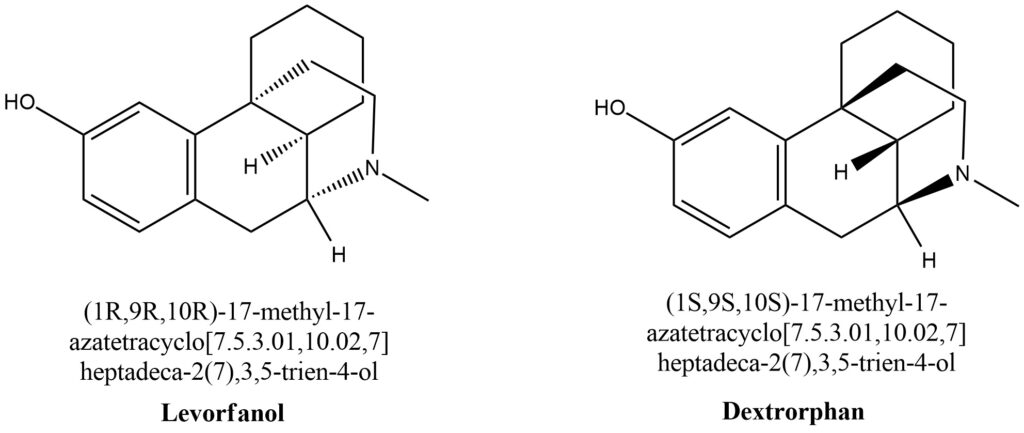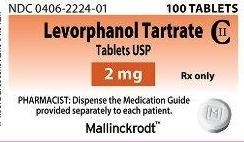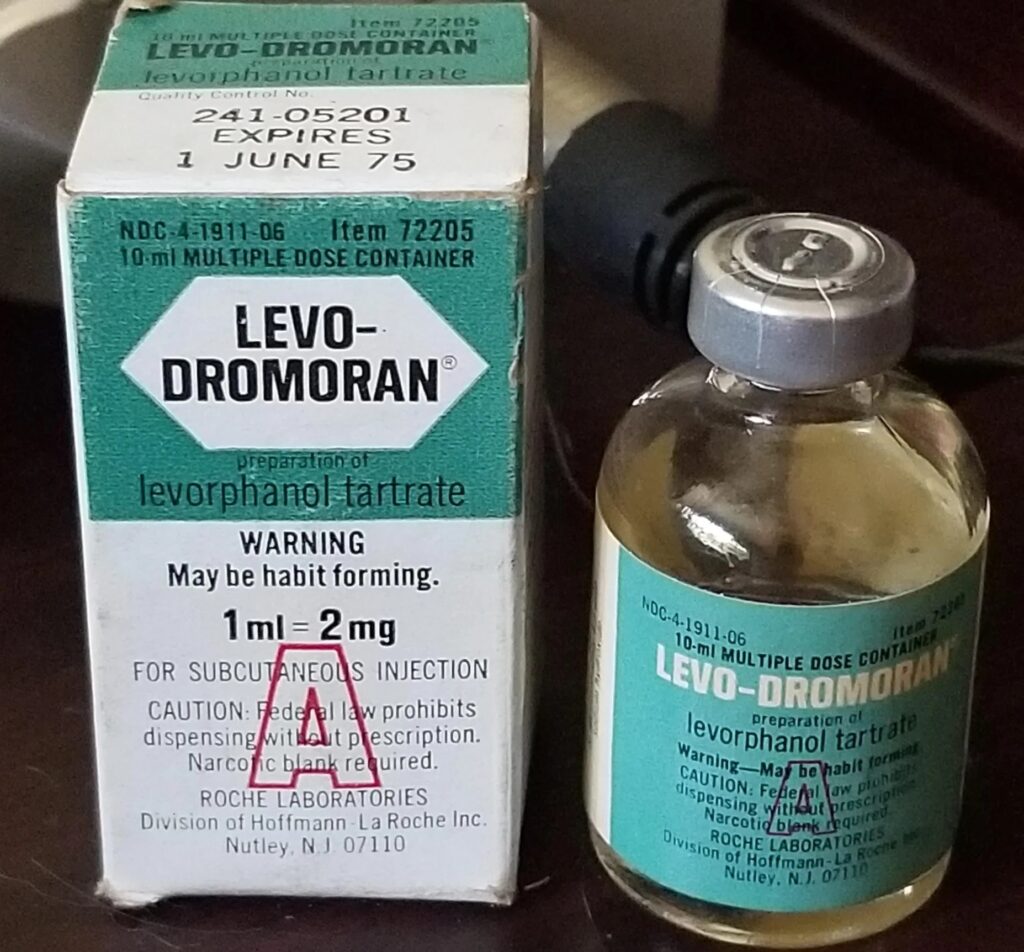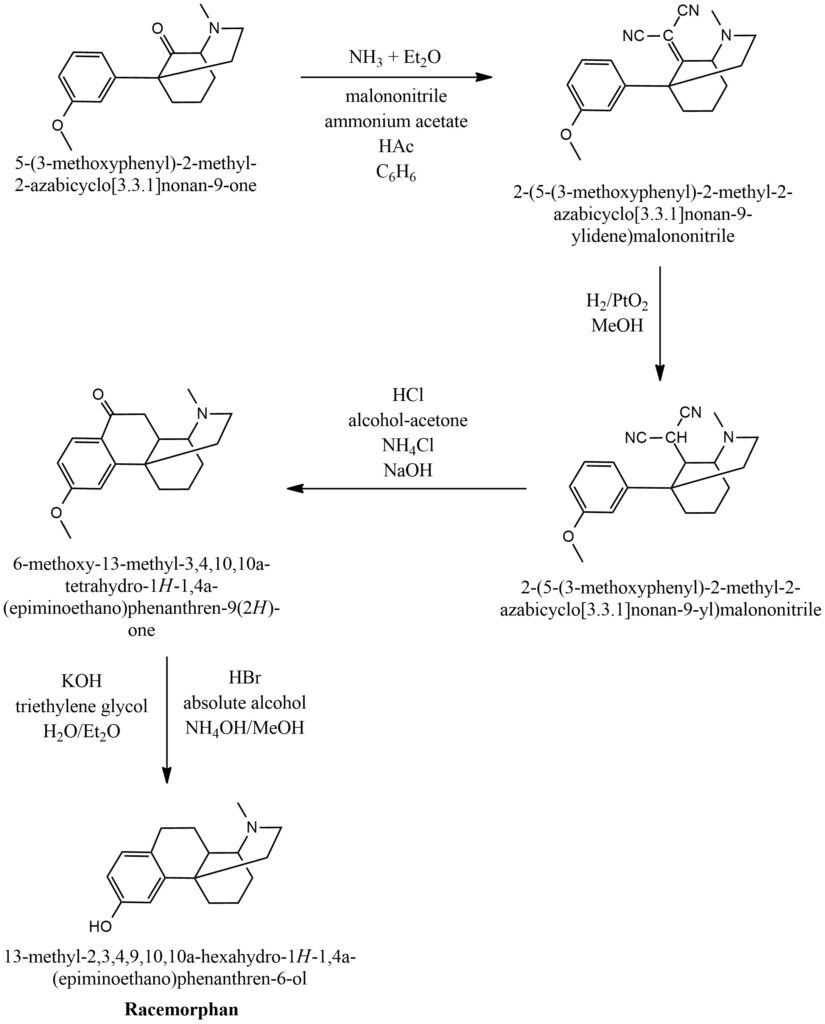Abstract
Racemorphan a potent opioid analgesic, and its isomer Levorphanol have garnered attention for their analgesic properties. This article provides examination of Levorphanol and Racemorphan, encompassing their fundamental characteristics, physico-chemical properties, recreational pharmacology, associated effects and symptoms, street nomenclature, price variations, approximate dosage guidelines, hazardous drug interactions, legal standings, Racemorphan synthesis, concluding remarks, and a comprehensive bibliography.
Narcotic Analgesics structure and IUPAC names Opioids
General Information About Levorphanol and Racemorphan [1-9]
Other synonyms names of Levorphanol and Racemorphan are: levorphanol; Levorphan; Aromarone; Methorphinan; Dromoran; Cetarin; Racemic dromoran; Orphan; Methorfinan; 17-Methylmorphinan-3-ol; N-Methyl-3-hydroxymorphinan; dl-3-Hydroxy-N-methylmorphinan; (-)-3-Hydroxy-N-methylmorphinan; Levorphanal; (4bR,8aR,9R)-11-methyl-6,7,8,8a,9,10-hexahydro-5H-9,4b-(epiminoethano)phenanthren-3-ol;
IUPAC Names of Levorphanol and Racemorphan: (1R,9R,10R)-17-methyl-17-azatetracyclo[7.5.3.01,10.02,7]heptadeca-2(7),3,5-trien-4-ol; 1,3,4,9,10,10a-Hexahydro-11-methyl-2H-10,4a-Iminoethanophenanthren-6-ol; 17-Methylmorphinan-3-ol; 17-methyl-17-azatetracyclo[7.5.3.01,10.02,7]heptadeca-2(7),3,5-trien-4-ol
CAS numbers are 297-90-5; 77-07-6; 125-73-5; 297-90-5
Various Racemorphan isomers are illustrated in Figure 1, showcasing the structural diversity within this compound.

Figure 1. Isomers of Racemorphan
Physico-Chemical Properties of Levorphanol and Racemorphan [1-9]
- Molecular Formula C17H23NO
- Molar Weight 257.37 g/mol
- Melting Point 198-199 °C (Levorphanol); 137.92 °C (Racemic); 131.27 °C (Dextrorphan)
- Solubility: Crystals; soluble in water; sparingly in alcohol; practically insoluble in ether
- Color/Form: Solid; Crystals
Levorphanol Tartrate and Levodromoran can be seen in the pictures provided in Figure 2 and Figure 3.

Figure 2. Levorphanol Tartrate

Figure 3. Levodromoran
General Information of Levorphanol and Racemorphan in Recreational Use and Pharmacology [1-11]
Racemorphan, also known as morphanol, encompasses a blend of two stereoisomers of 17-methylmorphinan-3-ol, each yielding distinct pharmacological effects:
Dextrorphan (DXO) – A dual-acting compound with properties as an antitussive and a dissociative hallucinogen, achieved through its role as an NMDA receptor antagonist.
Dextrorphan shares pharmacological similarities with dextromethorphan (DXM). However, dextrorphan surpasses DXM in potency as an NMDA receptor antagonist and exhibits less activity as a serotonin reuptake inhibitor. Nevertheless, it retains DXM’s ability to inhibit norepinephrine reuptake and demonstrates a stronger affinity for opioid receptors, particularly at elevated doses.
Levorphanol – A potent synthetic opioid analgesic employed for the treatment of moderate to severe pain. Levorphanol stands as a suitable choice for managing pain, and it can also serve as a preoperative medication when opioid analgesics are deemed necessary. Its actions mirror those of morphine, albeit with up to 8 times greater potency. Levorphanol induces a level of respiratory depression akin to that provoked by morphine at equianalgesic dosages. Similar to various mu-opioid drugs, levorphanol can elicit euphoria and positively influence mood in many individuals.
The use of levorphanol tartrate tablets carries inherent risks for patients and other users, including the potential for opioid addiction, misuse, and abuse, which may culminate in overdose and fatality.
Effects and symptoms of Levorphanol and Racemorphan Use [8, 10-12]
Levorphanol exhibits pharmacokinetic traits akin to methadone, offering an extended period of analgesic effectiveness that spans between 6 to 15 hours, coupled with an impressively prolonged half-life of up to 30 hours. This extended duration of action makes it a valuable tool in the management of moderate to severe pain, providing sustained relief to individuals in need.
While individuals who utilize prescription opioids may initially encounter feelings of relaxation and happiness, they often grapple with a range of side effects, including drowsiness, mental confusion, nausea, constipation, and slowed breathing. The allure of prescription opioids, however, extends beyond mere pain relief, as they can induce intense euphoria, trigger vivid imaginative experiences, and even lead to closed-eye hallucinations. These psychotropic effects, while enticing to some, underscore the potential risks and challenges associated with opioid use, including the potential for addiction and the need for careful medical supervision.
All effects in different categories [10]
General
- The adverse effects of this drug are generally similar to the adverse effects observed with other narcotic analgesics including nausea, vomiting, altered mood and mentations, pruritus, flushing, difficulties in urination, constipation, and biliary spasm
- Respiratory
- Frequency not reported: Apnea, cyanosis, hypoventilation
- Nervous system
- Cases of serotonin syndrome have been reported with concomitant use of serotonergic drugs
- Frequency not reported: Coma, convulsions, dizziness, lethargy, hypokinesia, dyskinesia, hyperkinesia, CNS stimulation
- Postmarketing reports: Serotonin syndrome
- Hypersensitivity
- Anaphylaxis has been reported with ingredients contained in the levorphanol tablets.
- Postmarketing reports: Anaphylaxis
- Cardiovascular
- Frequency not reported: Cardiac arrest, shock, hypotension, arrhythmias including bradycardia and tachycardia, palpitations, extra-systoles
- Gastrointestinal
- Frequency not reported: Nausea, vomiting, constipation, dyspepsia, biliary tract spasm, abdominal pain, dry mouth
- Genitourinary
- Frequency not reported: Urinary retention, difficulty urinating
- Dermatologic
- Frequency not reported: Pruritus, urticaria, rash, sweating
- Psychiatric
- Frequency not reported: Suicide attempt, depression, confusion, abnormal dreams, abnormal thinking, nervousness, drug withdrawal, personality disorder, amnesia, insomnia
- Renal
- Frequency not reported: Kidney failure
- Endocrine
- Postmarketing reports: Adrenal insufficiency, androgen deficiency
- Cases of adrenal insufficiency and androgen deficiency have been reported with opioid use. Adrenal insufficiency has more often been reported following use of greater than 1 month. Androgen deficiency has occurred with chronic opioid use.
- Ocular
- Frequency not reported: Abnormal vision, pupillary disorder, diplopia
- Symptoms of overdose
- Chest pain or discomfort
- constricted, pinpoint, or small pupils (black part of the eye)
- decreased awareness or responsiveness
- difficult or troubled breathing
- difficulty with sleeping
- dilated neck veins
- disorientation
- drowsiness to profound loss of consciousness
- extreme tiredness or weakness
- headache
- irregular, fast or slow, or shallow breathing
- no muscle tone or movement
- not breathing
- pale or blue lips, fingernails, or skin
- seeing, hearing, or feeling things that are not there
- sleepiness or unusual drowsiness
- swelling of the face, fingers, feet, or lower legs
- weight gain
Street Names, Prices and Approximate Dosage [10]
The typical initial dosage for levorphanol is 2 mg orally every 6 hours or 1 mg parenterally every 6 hours. You can find a package of 90 tablets at the cost of $578.
Dangerous interactions [10]
Simultaneous consumption of opioids alongside benzodiazepines or other central nervous system (CNS) depressants, such as alcohol, can lead to profound sedation, respiratory depression, coma, and, tragically, even fatalities.
Legal Status [1, 2, 8]
Racemorphan is subject to international regulations as outlined in the Single Convention on Narcotic Drugs 1961. It is classified as a Schedule II Narcotic controlled substance under the US Controlled Substances Act of 1970, assigned an ACSCN of 9733. In 2014, there was no annual manufacturing quota allocated for it. Various salts of racemorphan are employed, including hydrobromide (with a free base conversion ratio of 0.741), hydrochloride (0.876), and tartrate (0.632).
Racemorphan’s regulatory status varies by country:
- Australia (AU): Classified as S9, a prohibited substance.
- Brazil (BR): Designated as Class A1, a narcotic drug.
- Canada (CA): Categorized as Schedule I.
- Germany (DE): Listed under Anlage II, authorized for trade purposes only and not prescriptible.
- United Kingdom (UK): Classified as Class A.
- United States (US): Placed in Schedule II.
- United Nations (UN): Categorized as Psychotropic Schedule I.
- Dextrorphan, on the other hand, was previously classified as a Schedule I controlled substance in the United States but was subsequently removed from scheduling on October 1, 1976.
Synthesis of Racemorphan [12-14]
The synthesis of Racemorphan is extensively documented in articles [12, 13, 14], with the overall synthetic scheme illustrated in Figure 4.

Figure 4. General scheme of Racemorphan synthesis
Conclusion
Racemorphan, a controlled substance, is subject to rigorous international control measures established by the Single Convention on Narcotic Drugs in 1961. Within the United States, it holds the classification of a Schedule II Narcotic controlled substance, signifying its substantial potential for abuse and addiction. The regulatory classification of Racemorphan varies globally, exemplified by its status as a prohibited substance in Australia, a designated narcotic drug in Brazil, and a Schedule I substance in Canada, among other classifications.
Racemorphan is available in various salt forms, including hydrobromide, hydrochloride, and tartrate, each serving different purposes and possessing its distinct conversion ratio.
Dextrorphan, a derivative of Racemorphan, previously held a Schedule I controlled substance classification in the United States but was subsequently removed from scheduling in 1976.
The synthesis of Racemorphan has received comprehensive documentation in scientific articles, rendering valuable insights for researchers and industry professionals alike.
Bibliography
- https://en.wikipedia.org/wiki/Levorphanol
- https://en.wikipedia.org/wiki/Racemorphan
- https://pubchem.ncbi.nlm.nih.gov/compound/5359272
- https://go.drugbank.com/drugs/DB00854
- https://www.chemspider.com/Chemical-Structure.16736212.html
- https://pubchem.ncbi.nlm.nih.gov/compound/3918
- https://www.chemspider.com/Chemical-Structure.3781.html
- https://en.wikipedia.org/wiki/Dextrorphan
- https://www.drugs.com/imprints/m-29950.html
- https://www.drugs.com/sfx/levorphanol-side-effects.html
- https://www.sciencedirect.com/topics/medicine-and-dentistry/levorphanol
- O. Schnider, A. Grüssner Oxy-morphinane. (3. Mitteilung). Optisch aktive 3-Oxy-morphinane. Helvetica Chimica Acta, 1951, Vol. 34, Issue 7, pp. 2211-2217. https://doi.org/10.1002/hlca.19510340715 https://onlinelibrary.wiley.com/doi/abs/10.1002/hlca.19510340715
- EVERETTE L. MAY Structures Related to Morphine. X.1 A Position Isomer of (±)-3-Hydroxy-N-methylmorphinan (Racemorphan). J. Org. Chem., 1958, 23, 7, pp. 947–949. https://doi.org/10.1021/jo01101a002 https://pubs.acs.org/doi/pdf/10.1021/jo01101a002
- https://bbgate.com/threads/levorphanol-and-racemorphan-synthesis.969/

